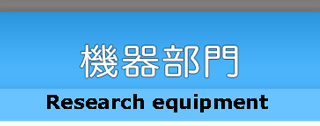

遠心機 Centrifuge
遠心機とは Centrifuge
遠心機は、試料を高速で回転させ、その時得られる遠心力を用いて、試料を密度の差で分離するための装置で、試料に遠心力をかけるためのローターとそれを回転させるための駆動部より構成されています。そして、安全確保のため回転部は丈夫なチャンバー内に収められています。
遠心機には、低速遠心機、高速冷却遠心機、分離用超遠心機等があり、また、ローターにも固定角ローター(Fixed-angle rotor)、水平ローター(Swinging-bucket rotor)、急速密度勾配により短時間で分離するのに用いる垂直ローター(Vertical tube rotor)などがあります。それぞれのローターには、容量、最高回転数が決められており、実験の目的に合わせて最適なローターを選択する必要があります。
A centrifuge is a device that uses centrifugal force to subject a sample to a specified constant force, for example to separate various components of a sample fluid. It consists of a rotor and a drive unit to rotate the rotor. This rotating unit is housed in a sturdy chamber to ensure safety. Centrifuges include low speed centrifuges, high speed refrigerated centrifuges, preparative ultracentrifuges. In addition, rotors include fixed-angle rotors, swinging-bucket rotors, and vertical tube rotors, which are used for quick separation with rapid density gradient centrifugation. Each rotor has a specific capacity and maximum speed, and the most appropriate rotor must be selected for the purpose of the experiment.
遠心機の種類 Common types
●低速遠心機 Low speed centrifuge
最高回転数3,000rpm程度の遠心機で、試料中の比較的大きな粒子(培養液中の培養細胞や血球等)の分離に用います。試料を冷却できるものもあります。(日立CF-7D2、Beckman Coulter GPR)
Low speed centrifuges have maximum rotor speeds of approximately 3,000 rpm and are used to separate relatively large particles in the sample (e.g., cultured cells in culture medium, blood cells). These may be equipped with a sample cooling function. (Hitachi/CF-7D2, Beckman Coulter/GPR)
●高速冷却遠心機 High speed refrigerated centrifuge
最高回転数20,000rpm程度の遠心機です。試料の温度が空気との摩擦熱で上昇しないように強力な冷却機を備えています。冷却の必要な試料や、低速遠心機では分離できない粒子の分離に用います。ローター室内を減圧(0.5気圧程度)するものもあります。(Beckman Coulter HP-25、HP-26、J-E)
High speed refrigerated centrifuges have maximum rotor speeds of approximately 20,000 rpm and are equipped with a powerful cooling machine to prevent the sample temperature from rising due to frictional heat with the air. These are typically used to separate samples that require cooling or harvest particles that cannot be separated by low speed centrifuges. High speed refrigerated centrifuge may have a function to depressurize the rotor chamber (about 0.5 atmospheric pressure). (Beckman Coulter/HP-25, HP-26, J-E)
●分離用超遠心機 Preparative ultracentrifuge
最高回転数が数万rpmの遠心機で数十万gの遠心力を得ることができます。ローターを非常に高速で回転させるのでローター室内を高真空に保つ仕組みになっています。この遠心機は、強大な遠心力を必要とするようなミクロソームやリポタンパク質等の分離に使用します。微量試料を迅速に遠心できる小型のものもあります。(Beckman Coulter Optima L-90K、Optima MAX-TL)
A preparative ultracentrifuge is a centrifuge optimized for spinning a rotor at very high speeds, capable of generating acceleration as high as several hundred thousand g. a high vacuum must be maintained in the rotor chamber. These are designed to maintain a high vacuum in the rotor chamber and used to harvest microsome and lipoprotein, which require high centrifugal force for separation. Small, bench-top ultracentrifuges can be used for rapid centrifugation of micro samples. (Beckman Coulter/Optima L-90K, Optima MAX-TL)
ローターの種類 Rotor Types
●固定角ローター(アングルローター) Fixed angle rotor
通常の遠心分離には固定角ローターを用います。固定角ローターには、様々な種類(駆動軸に対する遠心管の角度や容量)があるので、目的に応じたローターを選ぶ必要があります。
These rotors are very popular in the lab for routine use. There are various types of fixed angle rotors depending on the angle of the centrifugal tube to the drive shaft and the capacity, and the rotor must be selected according to the purpose.
●水平ローター(スウィングローター) Swing Rotor
このローターは遠心管を挿入したバケットがローターの回転と共に遠心方向にスウィングし、水平になるものです。バケットは常に遠心力の方向に向いているので、試料が舞い上がったり密度勾配が乱れたりしないため、主に密度勾配法による遠心分離に使用します。
These rotors have hinges where the bucket containing centrifugal tubes are attached. This allows all of the samples to swing outwards as the centrifuge is spun. These are mainly used for the density gradient centrifugation because the buckets are always kept in the direction of centrifugal force, preventing sample uplift and disturbance in the density gradient.
遠心管について Centrifuge tube
遠心分離を行なう試料は遠心管と呼ばれる容器に入れます。遠心機やローターに様々な種類があるように、遠心管にも様々な種類(材質、形状)があります。使用するローターに適合した遠心管(サイズ、耐荷重)を選ぶことは言うまでもなく、使用する溶媒への耐性や、滅菌の必要の有無などから判断し、適切な遠心管を用いることが必要です。
The sample to be centrifuged is placed in a container called a centrifuge tube. Centrifuge tubes may vary in materials and shapes. In addition to selecting the appropriate centrifuge tube for the rotor to be used, the optimal centrifuge tube must be used based on the resistance to the solvent to be used and the need for sterilization.
参考資料 Manual
遠心機の安全な取り扱いについて(Japanese ver.)(学内のみ)
簡易操作マニュアル(Japanese ver.)(学内のみ)
 前へ 前へ
|
先頭へ
|
Last Updated 2023/8/14








